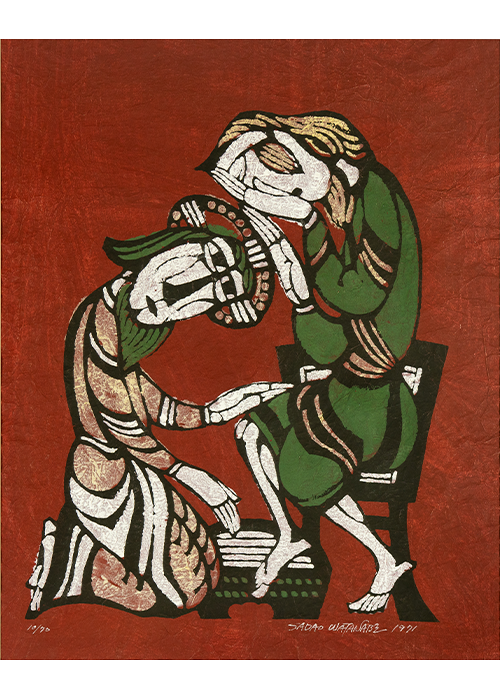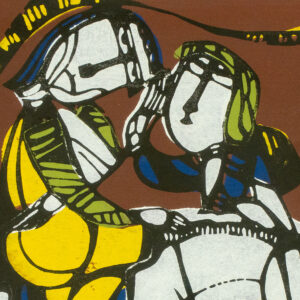Print descriptions written by Br. Matthew Sislow, OSB, in collaboration with Fr. Nathan Zodrow, OSB.

Baby Moses Abandoned
Image: 12.75″ x 8.75″
This 1979 print depicts the baby Moses abandoned in a basket on the river Nile. The print shows Jachebed, mother of Moses, placing the ornate basket in the dark water for the daughter of Pharaoh to find when she goes to the water to bathe. The background suggests a river bank with thick reeds and a duck or Heron flying overhead. While signed, dated, and with chop, the print is not numbered.
 Moses and Miriam
Moses and Miriam
Image: 20.5″ x 23.5″
This 1966 print (4/50) depicts two figures, Moses and his older sister, Miriam. Moses, with a staff in his left hand and his right hand over his head, is encouraged by Miriam as he leads the Israelites to the Promised Land. The two are set against a background of colorful hand-painted mounds suggesting a desert landscape.
 Siege of Jericho
Siege of Jericho
Image 22″ x 25.375″
This 1966 print (30/50) depicts five Israelite soldiers engaged in the Battle of Jericho with the city walls in the background. In order to enter the Promised Land, the soldiers march around the Canaanite city blowing trumpets to bring down the walls. The walls seem impermeable but faith suffices.
 Prophet Elijah
Prophet Elijah
Image: 7″ x 8.125″
This 1967 print depicts the Prophet Elijah being taken to heaven in a whirlwind of fire after he had passed the prophet’s mantle to his successor, Elisha. The chariot and horses were sent from heaven to get Elijah. This simple mingei-style piece is printed predominantly in black and white on cream colored paper. While signed and dated by the artist, the print is not numbered.
 Nativity
Nativity
Image: 4.5″ x 6.125″
This mingei-style print depicts Mary holding the infant Jesus, with two other people, possibly shepherds, visiting her. There is a large bird, perhaps a heron, at their feet, and behind the figures, a stable with a horse looking on. In the foreground three large flowers with a suggestion of hills in the far background. The piece is mostly black with some color on white paper. While signed by the artist the print is not numbered or dated.
 At the Well
At the Well
Image: 4.5″ x 6.125″
This mingei-style print depicts the Holy Mother with the Christ Child sitting on her lap. They are under a bright star while chatting with another woman at a well. The other woman’s bucket is at her back. The stencil print is created predominantly using hues of blue, gray, red, and yellow over a design of black ink on white paper. While signed by the artist, the print is not numbered or dated.
 Flight to Egypt
Flight to Egypt
Image: 22.625″ x 19″
This 1987 richly detailed stencil print (37/100) depicts Mary riding a donkey through a field of flowers while holding the infant Jesus. The white donkey is led by St. Joseph. In the deep red background are the walls of a structure topped by decorative vegetation. Mary is in a gold veil and St. Joseph, with hat, wears a vertical striped garment of black and gold. In his right hand is a staff or lamp. Both Mary and St. Joseph have worried expressions.
 Christ’s Invitation
Christ’s Invitation
Image: 18.625″ x 21.75″
This 1973 stencil print (25/70) depicts Christ calling Peter and Andrew from their fishing boat to follow him. While their faces and hands eloquently express astonishment, confusion and fear, Jesus gently touches them with his hand. Four stripes with horizontal “<” patterns represent dark water movement. Christ is wearing a green kimono while those called are in blue and red respectively.
 Healing the Lame
Healing the Lame
Image: 19.5″ x 25.25″
This 1972 print (8/70) depicts Christ raising a hand with the gentile finger of authority in blessing and healing over the lame person sitting before him in supplication. The person reaches to him who gently touches her and makes her whole. Christ is wearing a patterned white and black kimono, while the woman wears deep red. In the golden background are suggestions of hillsides and exotic vegetation in predominantly black and white ink.
 Good Samaritan
Good Samaritan
Image: 10.5″ x 12.25″
In this mingei-style print, the Good Samaritan has placed the brutalized and nearly naked man on his own donkey before taking him to an inn. On the far right stand two women, possibly at the inn, looking on. One has her hand placed on the back of a bird. At the bottom we see a cloak or satchel of the victim in the ditch where he was left. We depend on the kindness of others along the journey.
 Prodigal Son
Prodigal Son
Image: 19.75″ x 23.5″
This 1973 print (22/70) depicts the parable from St. Luke’s Gospel of the prodigal son. Here the son kneels before his father asking forgiveness for his life of debauchery. The father (Jesus), dressed in a kimono of gray-green and white, takes his son’s hand in his own. The son, wearing a garment of white with semi-circular patterns of dark red and black, bows in supplication. In the background, two structures suggest the father’s property or kingdom.

Last Supper
Image: 8.25″ x 11.125″
This 1973 print of the last supper depicts Jesus with halo and the 12 apostles, dressed in traditional Japanese kimono. A large fish in the center of the table with other food items around suggests the service of sake and sushi. In this tightly gathered assembly, garments are predominantly black and cream with some light colored accents. While signed and dated by the artist, the piece is not numbered.
 Washing the Feet
Washing the Feet
Image: 17.875″ x 22.75″
In this 1971 print (10/70), Jesus is depicted washing the feet of a disciple (presumed to be Peter) who is sitting. Peter places one hand over his face in embarrassment and the other he raises in protest. Jesus encourages Peter by placing his hand gently on Peter’s knee. The background is deep red with no additional patterns, while the disciple is wearing green and Christ a white loincloth.
 Descent from the Cross
Descent from the Cross
Image: 21.25″ x 27″
In this 1973 print (56/70), the limp body of Christ is being lowered from the richly decorated cross while the apostle John, Mary, the mother of Jesus, Mary Magdalene and others look on. Against the cross leans a ladder, reminiscent of Jacob’s ladder, down which Jesus is lowered. Mary stands on the right overcome with sorrow. The background is in deep red while John and Mary are in green and blue respectively.
 St. Francis Preaching to the Birds
St. Francis Preaching to the Birds
Image: 15″ x 20.375″
This 1979 print (6/70) depicts a serene St. Francis with white beard, gird with the white Franciscan cord, and surrounded by many birds. The stylized birds cling to vines on a gold colored background, all with ears attentive to St. Francis. One bird, alight on St. Francis arm, pays close attention as St. Francis preaches the Gospel. One might conclude that Sadao Watanabe had much in common with St. Francis.


 Today, Sadao Watanabe has been internationally recognized, with his works in the collections of the Vatican Museum, White House, Museum of Modern Art in New York, Art Institute of Chicago, and the National Museum of Art, as well as the Mount Angel Abbey Art Collection (!).
Today, Sadao Watanabe has been internationally recognized, with his works in the collections of the Vatican Museum, White House, Museum of Modern Art in New York, Art Institute of Chicago, and the National Museum of Art, as well as the Mount Angel Abbey Art Collection (!). Mingei is Japanese for folk art. Influenced by Buddhist figure prints, Watanabe placed biblical subjects in a Japanese context. In The Last Supper (1981) Watanabe depicts the disciples in kimono. On the table are bottles of sake and sushi. Watanabe once remarked that he preferred that his prints hang in the ordinary places of life: “I would most like to see them [his prints] hanging where people ordinarily gather, because Jesus brought the gospel for the people“. Such is the mingei philosophy of art for the people and by the people. (Artnet)
Mingei is Japanese for folk art. Influenced by Buddhist figure prints, Watanabe placed biblical subjects in a Japanese context. In The Last Supper (1981) Watanabe depicts the disciples in kimono. On the table are bottles of sake and sushi. Watanabe once remarked that he preferred that his prints hang in the ordinary places of life: “I would most like to see them [his prints] hanging where people ordinarily gather, because Jesus brought the gospel for the people“. Such is the mingei philosophy of art for the people and by the people. (Artnet) Katazome is a Japanese method of dyeing fabrics using a resist paste applied through a stencil. The stencils used are called Katagami. In Japanese, this means “pattern paper” (kata = pattern and gami = paper). The stencils were developed and used primarily for printing on fabrics for kimono; however the technique was used by artists to produce prints on paper as well. (Washi Arts)
Katazome is a Japanese method of dyeing fabrics using a resist paste applied through a stencil. The stencils used are called Katagami. In Japanese, this means “pattern paper” (kata = pattern and gami = paper). The stencils were developed and used primarily for printing on fabrics for kimono; however the technique was used by artists to produce prints on paper as well. (Washi Arts)
 Moses and Miriam
Moses and Miriam Siege of Jericho
Siege of Jericho Prophet Elijah
Prophet Elijah Nativity
Nativity At the Well
At the Well Flight to Egypt
Flight to Egypt Christ’s Invitation
Christ’s Invitation Healing the Lame
Healing the Lame Good Samaritan
Good Samaritan Prodigal Son
Prodigal Son
 Washing the Feet
Washing the Feet Descent from the Cross
Descent from the Cross St. Francis Preaching to the Birds
St. Francis Preaching to the Birds